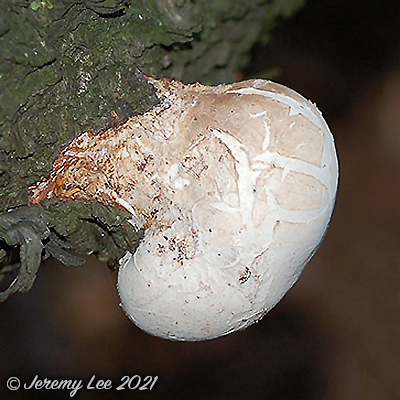
 |
|
Scientific Classifications explained » Amphibians » Ants » Aphids » Bees » Beetles » Birds » Bugs » Butterflies » Caterpillars » Damselflies » Dragonflies » Earwigs » Flies » Frog/Leafhoppers » Fungi » Galls » Grasshoppers » Harvestmen » Hoverflies » Lacewings » Ladybirds » Leaf Mines » Lichens » Mammals » Millipedes » Mosses » Moths » Sawflies » Slugs » Snails » Spiders » Trees & Shrubs » Wasps » Wild Flowers » Woodlice » Postboxes |
UK Nature > Fungi > Piptoporus betulinus

Scientific Name: Piptoporus betulinus Common Name: Birch Polypore Anyone who has spent time in birch woods has seen Piptoporus betulinus on dead birch trees and logs, or occasionally on living trees. The species is an attractive polypore, easily recognized by its habitat on birch wood and the fact that the cap folds over to make a distinctive, smooth rim around the pore surface. The caps are whitish to brownish, and the pore surface is whitish or grayish brown. Although Piptoporus betulinus is annual and does not actually live for more than one season, its fruiting bodies are somewhat tough and are sometimes found in the next year (usually somewhat blackened). It develops from a small white spherical swelling on the side of dead or living birch trees. Barbers used to 'strop' or sharpen their cut-throat razors on tough, leathery strips cut from the surfaces of these polypores, and so they became known as the Razor Strop Fungus. |
|

https://www.uknature.co.uk is a website dedicated to showing the immense diversity of UK nature and wildlife. Our vast range of habitats, from lowland arable to snow covered mountains, from storm-ravaged coastlines to peaceful inland freshwater lakes and rivers, from dry, sandy heaths to deciduous and coniferous forests, all these habitats contribute to the abundance of UK nature. We have wild birds in huge numbers either residing or visiting our shores (597 recorded species as at July 2013) and we must also not forget the humble back garden with its grass lawns, flower beds filled with nectar rich flowers, shrubs and trees, all designed to attract huge numbers of insects such as bees, moths, butterflies and hoverflies; and finally the small ponds which provide safe havens for frogs, toads, newts and even slow worms and grass snakes. www.uknature.co.uk is the showcase for my personal passion, photographing uknature in all its glory. I sincerely hope you all enjoy the fruits of my labours. This site and all images contained therein is © Jeremy Lee 2004 - 2025. All Rights Reserved. Site design by Jeremy Lee. Site development & IT Support by Stuart Lee. |